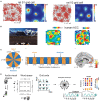Are Grid-Like Representations a Component of All Perception and Cognition?
- PMID: 35911570
- PMCID: PMC9329517
- DOI: 10.3389/fncir.2022.924016
Are Grid-Like Representations a Component of All Perception and Cognition?
Abstract
Grid cells or grid-like responses have been reported in the rodent, bat and human brains during various spatial and non-spatial tasks. However, the functions of grid-like representations beyond the classical hippocampal formation remain elusive. Based on accumulating evidence from recent rodent recordings and human fMRI data, we make speculative accounts regarding the mechanisms and functional significance of the sensory cortical grid cells and further make theory-driven predictions. We argue and reason the rationale why grid responses may be universal in the brain for a wide range of perceptual and cognitive tasks that involve locomotion and mental navigation. Computational modeling may provide an alternative and complementary means to investigate the grid code or grid-like map. We hope that the new discussion will lead to experimentally testable hypotheses and drive future experimental data collection.
Keywords: attractor; cognition; grid cell; perception; recurrent neural network.
Copyright © 2022 Chen, Zhang, Long and Zhang.
Conflict of interest statement
The authors declare that the research was conducted in the absence of any commercial or financial relationships that could be construed as a potential conflict of interest.
Figures



Similar articles
-
The grid code for ordered experience.Nat Rev Neurosci. 2021 Oct;22(10):637-649. doi: 10.1038/s41583-021-00499-9. Epub 2021 Aug 27. Nat Rev Neurosci. 2021. PMID: 34453151 Free PMC article. Review.
-
Grid-like hexadirectional modulation of human entorhinal theta oscillations.Proc Natl Acad Sci U S A. 2018 Oct 16;115(42):10798-10803. doi: 10.1073/pnas.1805007115. Epub 2018 Oct 3. Proc Natl Acad Sci U S A. 2018. PMID: 30282738 Free PMC article.
-
Grid-cell representations in mental simulation.Elife. 2016 Aug 30;5:e17089. doi: 10.7554/eLife.17089. Elife. 2016. PMID: 27572056 Free PMC article.
-
Mapping of a non-spatial dimension by the hippocampal-entorhinal circuit.Nature. 2017 Mar 29;543(7647):719-722. doi: 10.1038/nature21692. Nature. 2017. PMID: 28358077 Free PMC article.
-
Grid coding, spatial representation, and navigation: Should we assume an isomorphism?Hippocampus. 2020 Apr;30(4):422-432. doi: 10.1002/hipo.23175. Epub 2019 Nov 18. Hippocampus. 2020. PMID: 31742364 Free PMC article. Review.
Cited by
-
Empirically validated theoretical analysis of visual-spatial perception under change of nervous system arousal.Front Comput Neurosci. 2023 May 12;17:1136985. doi: 10.3389/fncom.2023.1136985. eCollection 2023. Front Comput Neurosci. 2023. PMID: 37251600 Free PMC article.
-
Excitatory-inhibitory recurrent dynamics produce robust visual grids and stable attractors.Cell Rep. 2022 Dec 13;41(11):111777. doi: 10.1016/j.celrep.2022.111777. Cell Rep. 2022. PMID: 36516752 Free PMC article.
References
-
- Barry C., Burgess N. (2007). To be a grid cell: shuffling procedures for determining gridness. BioRxiv. preprint.
Publication types
MeSH terms
LinkOut - more resources
Full Text Sources

